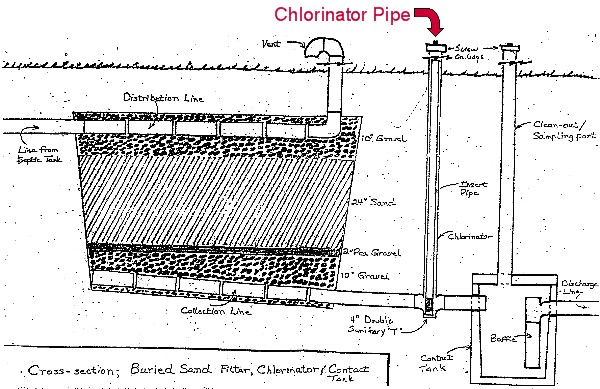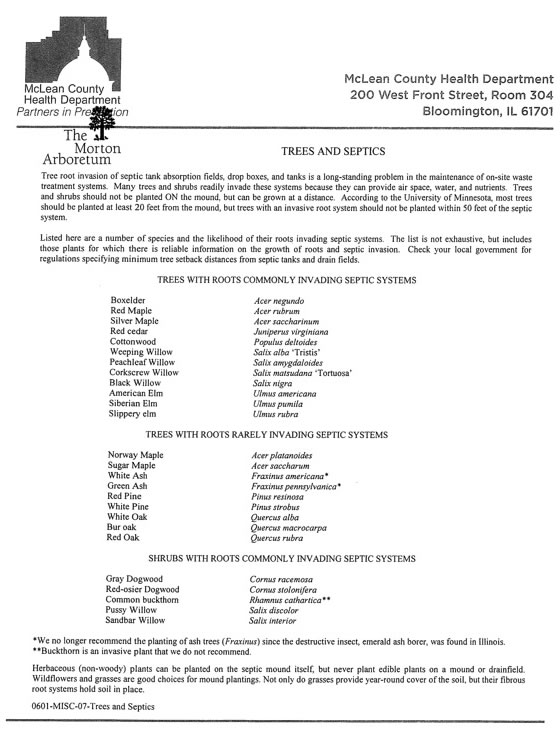Indian Creek
Your Septic SystemTreating
the wastewater, by Greg BenezeIllinois Administration Code, Section 905.120 requires that wastewater effluent which is discharged to the ground surface and leaves the property, or which is discharged into a pond, lake, or stream in which swimming, water skiing, or other water contact occurs shall be disinfected with a chlorine solution.
Many of the houses in Indian Creek have a sand filtered septic system for wastewater treatment. How do you know if you have one? A sand filter septic system has three above ground components: 1) a vent filter, which is often a T shaped PVC pipe, 2) a capped PVC pipe for the chlorinator, and 3) a capped PVC pipe used for clean out and taking samples. The chlorinator pipe is usually the capped pipe between the vent and the clean-out pipe.
To treat your wastewater, you need to place a chorine disinfectant tablet in the chlorinator pipe on a monthly basis. There are two types of chlorine tablets found on the market: calcium hypochlorite and chlorinated isocyanurates. Calcium hypochlorite tablets should be used for wastewater treatment. Brand names include Norweco’s Blue Crystal or Bio-sanitizer tablets. These tablets are very reactive and quickly kill bacteria present in wastewater. Just as importantly, the chlorine residual dissipates rapidly so that it will not damage the receiving environment, which in our case is Money Creek.
The other type of chlorine tablet is chlorinated isocyanurates, which are commonly called swimming pool tablets or “Tri-Chlors”. DO NOT USE TRI-CHLORS. Tri-Chlors dissolve more slowly and create a residual that does not readily dissipate. Designed to be total immersed in water, Tri-Chlor tablets that are exposed to periodic flows of a septic system begin to decompose and release an explosive gas called nitrogen trichloride. Tri-chlor tablets should not be used in your septic system as it is dangerous and violates Section 905.120 since Tri-Chlors are not labeled as suitable for wastewater treatment.
All chorine products are hazardous and must handled with care. Calcium hypochlorite tablets can be purchased on the Internet. Bio-sanitizer tablets are sold at the local ACE Hardware store on College Ave in Normal. A 10 pound bucket (32 tablets) is $51.99 and a 25 pound bucket (80 tablets) is $94.99. You might consider splitting the cost of a 25 pound bucket with a couple of your neighbors. I purchased tablets from Cary Zeschke for $1.50 each when he pumped out my septic tank. Zeschke Septic Cleaning is at 408 S. Robinson in Bloomington (309-530-4282 or 828-3535). Cary recommended using one tablet per month for our household of 2. He cautioned me not to overload with tablets as they can “gum-up” the chlorinator pipe.
I learned at the January, 2009, homeowners meeting that the McLean County Health Dept. tested one of the houses in our subdivision when it sold this summer and finding no presence of chlorine in their sand filter septic, fined the sellers.
Septic System Facts and Tips
Keep trees and shrubs at least 35 feet away from your field to prevent roots from plugging or breaking pipes. The roots of a tree will go out as far as the branches.
Limit the water entering your septic tank, and give your system time to rest after heavy use. Use water saving fixtures, repair leaky toilets and dripping faucets. Do not connect foundation sump pumps or other ‘clean water’ discharges to your septic system.
Driveways, patios, aboveground pools and other structures should not be built over the absorption field. As much as 1/3 of the water in septic fields evaporates up through the ground over the absorption field.
Avoid using garbage disposals. They add tremendously to the volume of solids entering a septic tank.
Use toilet paper that decomposes easily. Purchase brands labeled ‘safe’ for septic systems.
Keep water softener discharges out of your septic system.
Read product labels. Use low phosphorus detergents and cleaning products. Avoid anti-bacterial products and chlorine bleach.
Never flush things like disposable diapers, bones, sanitary napkins, tampons, coffee grounds, plastic band aids, dental floss, and cigarette butts. They will not break down.
Route surface water drainage away from your absorption field. Snowmelt, rain, and other surface runoff can temporarily inundate your field.
Additives are not needed because there are enough natural bacteria in the tank. No additive can alleviate the need to regularly pump your septic tank; some may actually promote clogging of your absorption field or contaminate groundwater. Save your money.
Maintain scheduled cleaning. Replacing the system is expensive and inconvenient. A septic system is about the most expensive part of your home and yet is the most neglected (out of sight, out of mind).
The main way to avoid septic system failure is periodic tank pumping. You HAVE to do this. When a tank is not pumped often enough, there is less settling time for waste entering the tank. Small bits of floating solids are then carried out into the leach field and begin clogging the soil. This will shorten and eventually end its life.
The frequency of pumping depends on tank size, the volume of wastewater (number of occupants), and the amount of solids in the wastewater (garbage disposal). A family of four, without a garbage disposal, would need to have a 1000 gallon tank cleaned every 2.5 years; 4 years for a 1500 gallon tank. See http://handymanusa.com/articles/septiccare.html for estimates of needed septic tank pumping frequencies.
|
Home Burning Bylaws Covenants History Maps Newsletters Phones Septic Recycling Water Aerial Animals Birds Bluebells Fungi Gardens Invasives Pets Streets Trail Trees Wildflowers |
This page was last updated July, 2020.

